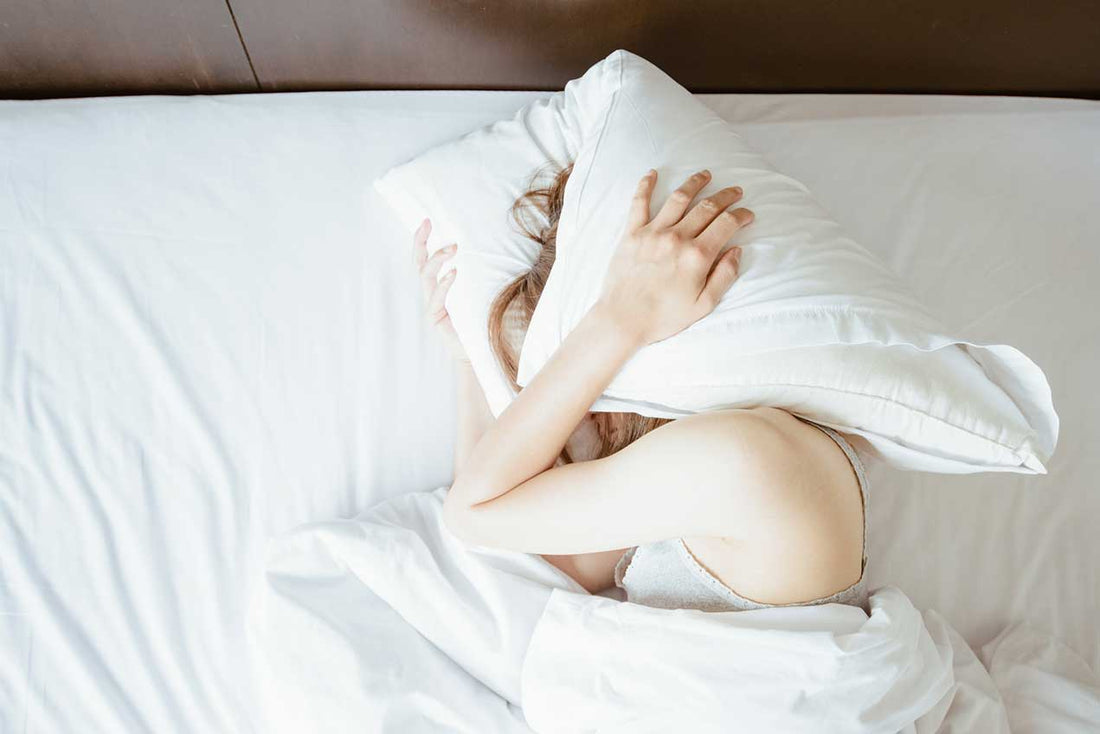Read Time: 6 min | Categories: Mental Health and Sleep
What is Insomnia and How Can You Combat It?
Leigh Matthews, BA Hons, H.Dip. NT
Share this article
One in five Canadians get fewer than five hours of sleep a night, and almost a quarter have trouble sleeping when stressed [4].
If you’re having difficulty falling asleep or staying asleep, learning about the science of insomnia could help – as could an exciting breakthrough in sleep science, called “pink noise”!
What is Insomnia?
According to the Diagnostic and Statistical Manual of Mental Disorders, 5th Edition (DSM-5), insomnia can be defined as:
“A predominant complaint of dissatisfaction with sleep quantity or quality, associated with one (or more) of the following symptoms:
- Difficulty initiating sleep
- Difficulty maintaining sleep, characterized by frequent awakenings or problems returning to sleep after awakenings and,
- Early-morning awakening and unable to return to sleep.”
If you experience these symptoms three or more nights per week for at least three months without any obvious cause for the symptoms, it’s possible that you have primary insomnia.
Symptoms of insomnia can also be brought on by another sleep-wake disorder, the use of substances (including alcohol and stimulants), and by other medical issues. Such cases are referred to as secondary insomnia.
For many people, a lack of sleep may simply be the result of a busy schedule, a new baby, or some other factors that decrease the opportunity for adequate sleep.
Secondary insomnia and situational insomnia are best resolved by addressing the underlying cause. Primary insomnia can be more difficult, but not impossible to manage.
If you regularly have trouble with sleep, it’s important to talk to your physician and determine whether any underlying medical issues or sleep disorders could be contributing to your sleep problems.
Who Suffers from Insomnia?
Millions of Canadians experience insomnia, including some 22% of women and 16% of men over the age of 75. On average, significantly more women (15%) than men (12%) report insomnia, which may be, in part, due to hormonal changes related to menstruation, pregnancy, and menopause [4].
Unsurprisingly, people who report higher levels of stress tend to suffer more from insomnia [4]. Research suggests that as many as 90% of people with depression experience sleep troubles, with around two-thirds experiencing insomnia [1].
 The Negative Effects of Insomnia
The Negative Effects of Insomnia
If you find it hard to calm your racing mind and get to sleep, it’s probably not going to help to know that even a single night of fitful sleep can affect your physical and emotional health.
Insomnia is associated with a range of health conditions, including depression, hypertension, diabetes, and cardiac events, possibly due to an altered stress response [4].
The Compendium of Therapeutics for Minor Ailments, 2nd edition, published by the Canadian Pharmacists Association in 2016 states that:
“Insomnia is associated with more frequent use of health care services, more days with limited activity, more days spent in bed, impaired job performance, higher rates of absenteeism, increased risk of traffic and workplace accidents, and reduced quality of life.”
In a large population study published in the European Heart Journal, data taken over 11 years from 54,279 people aged 20–89 showed that those who reported three symptoms of insomnia had at least a three-fold increased risk of developing heart failure compared to people without symptoms of insomnia.
The three major symptoms were trouble falling asleep, problems staying asleep, and not waking up feeling refreshed in the morning [3].
What Can You Do About Insomnia?
As with many disorders, first-line treatment of insomnia focuses on lifestyle interventions rather than medications. In addition to practising good sleep hygiene, you might also want to consider stimulus control therapy and relaxation.
Sleep hygiene focuses on such things as making sure your bedroom is cool, minimizing noise and light, avoiding stimulants and heavy meals 4–6 hours before bed, and exercising regularly, particularly in the afternoon.
Ideally, you should stop using screens at least an hour before bedtime. If you can’t avoid using screens, consider using software to filter out the blue light that interferes with melatonin synthesis.
Stimulus control means:
- Not going to bed unless sleepy
- Sticking to a consistent wake-up time
- Limiting napping, or only taking short naps and,
- Minimizing non-sleep activities in bed
To help you get better sleep you might consider relaxation techniques such as meditation and yoga. Some people also find it helpful to set aside a specific “worry period” to address intrusive thoughts before bedtime.
Natural health products may also help you to relax and relieve occasional sleep difficulties. For instance, the amino acid L-theanine can help calm an overactive mind and offer support if you’re feeling “tired and wired”. And, where appropriate, your physician may recommend pharmacologic interventions for insomnia such as sedatives or hypnotics.
Sleep Quantity Versus Quality
Getting enough sleep can be a challenge, but it’s also important to look at the quality of your sleep. The most restorative type of sleep is deep sleep.
If you’re waking up frequently during the night (whether you know it or not!) you may be missing out on this important phase of sleep.
In some cases, simple white noise can mean the difference between fractious sleep and deep, restorative sleep. White noise isn’t just for infants, so if you find yourself waking up to outside noise during the night consider running a fan or white noise machine at bedtime.
Sleep apnea is another potential cause of disturbed sleep. Often, people with undiagnosed sleep apnea wake up multiple times during the night, but fall back to sleep without registering having woken.
In such cases, it’s not unusual for a person to wake up feeling tired despite having spent eight hours in bed. A sleep study can determine if sleep apnea or other issue is causing you to feel tired.
A proper diagnosis is the first step to getting proper, restorative sleep.
Innovations in Sleep Science
Sleep science is a fascinating field of study, with one exciting area of research focusing on the use of “pink noise” to encourage deep sleep. After analyzing a person’s sleep cycle, researchers can predict when they will experience slow wave activity (SWA), an aspect of deep sleep.
Pink noise is an oscillating (sort of whooshing) sound, which appears to deepen sleep if applied just before SWA is predicted.
In one recent study, researchers looked at the effects of acoustic stimulation on slow wave action (SWA), which has been linked to better performance on memory tests.
The small study involved 13 adults aged 60–84 years who slept one night with the pink noise and one night with sham stimulation (where no noise was applied). The results suggested that pink noise may have benefits for deeper sleep and could support sleep-dependent memory storage in older adults [3].
The science of deep sleep and pink noise is still in its infancy, so while researchers continue working hard, your best bet for a good night’s sleep is to follow the sleep hygiene tips above.
Learn more about how to get a better sleep in our blog, 5 Tips to Get a Better Night's Sleep.
